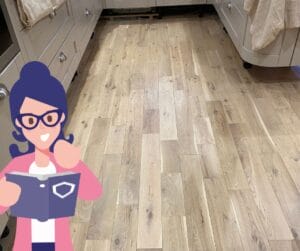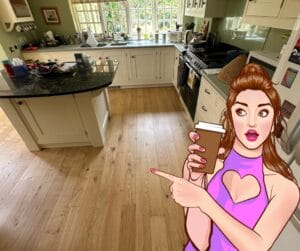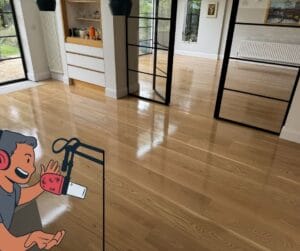Wood Floor Refreshing
After years of use you may notice your wood floor look in need of some work. This article is to help you understand what level of work would suit your floor best and why.
Most floors installed comes with a pre applied finish that cures fast, mostly by using a UV (Ultraviolet) light. This allows for the planks to be packed up and shipped out much faster. This also keeps the warehouse smaller as not much space is needed for the boards to be laid out to allow for curing like when an air cured finish is applied.
The UV (Ultraviolet) Cured (Also Known as UV cured finishes) are mostly very tough and hard wearing. It is also true that these coatings are applied much thinner than compared to On-Site applied finishes.
This means that pre-finished wood floors will eventually need care and restoration.
In most cases – Your wood floor supplier or installer can provide you with aftercare care products to refresh the floors when needed. Best would be to use the advised products to refresh your floor when it needs a little lift.
Wood Floor Sanding
It is when you have deeper scratches and scuff marks when Wood Floor Sanding may be needed. This is when the old finish is completely removed, and a new coating is applied. It is essential to fully remove the old finish to prepare the wood floor for a fresh even coat. The industry standard is to apply one coat of Primer to the bare wood and once dry a coat of the Lacquer finish is applied. These 2 coats are left to dry fully where after it is keyed back to achieve a smooth floor. A final coat of Lacquer is then rolled on to give you a smooth hard-wearing finish that will last for many years (if you care for it in the right way) The best Lacquer for the above process will be a 2-component commercial grade finish like Pallmann 98 Gold
In the case where Oil is applied to the wood floor instead of Lacquer (Or Wood Floor Varnish – like it was called many years ago)
The wood floor is sanded back fully where after a coat of oil is applied to penetrate the wood. This is then buffed in, and a 2nd coat of oil is applied and buffed in using a special rotary wood floor buffer. The floor is then buffed clean and dry and left to cure. The best oil for this Process is a 2-Component penetrating oil like Pallmann Magic Oil
Wood Floor Restoration
Wood Floor restoration is a term that is many times used when reference is made to wood floor sanding.
For this article we refer to Wood Floor Restoration as when a wooden floor needs more than just Sanding.
In most cases wood floor restoration will mean some broken boards in the floor needs to be replaced. This happens mostly on Victorian Pine Floors though it is not unusual to see Oak or other hard wood floorboards being replaced.
The replacement of boards will happen prior to the floor getting sanded and finished.
With so many reclamation yards closing it is getting harder and harder to find good quality boards to use that match old floors. In the case of Victorian pine floors we do see a lot of newer one boards being used in the restoration process and then they appear lighter once the floor is finished.
A floor sanding firm worth its sault will advise you before hand that you may likely see a colour variation if newer boards have been laid in. It is not uncommon to see a true Artisan have worked his magic and stained lighter boards to match the older boards. This only becomes apparent once the floor is sanded back.
To colour match very old boards is not impossible to do though it is an extremely time-consuming task and many times not valid if the investment.
In cases where old floors need extensive restoration it may be more economical to consider replacing the floor all together.
This is usually the case when the floorboards have been cut in many places for access below the floor, The floorboards may have been replaced with lighter pine or in some cases gaps would have been filled in with Concrete. We would advise you to get a quote for replacing the wood floor as well as a quote for restoration and you can then make an informed decision.

















